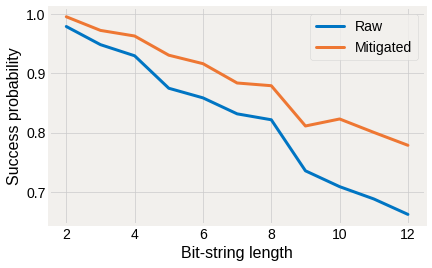Mitigating sampling problems¶
There are many cases where one is interested in computing the most probable bitstring in the output distribution from a circuit. Although, M3 returns quasi-probabilities, the most likely bit-string is something that is always positive, and we can mitigate sampling problems of this form. Below is a simple example for Bernstein–Vazirani (BV) circuits.
Frontmatter¶
[1]:
from qiskit import *
from qiskit.providers.fake_provider import FakeKolkata
import mthree
import matplotlib.pyplot as plt
plt.style.use('quantum-light')
[2]:
backend = FakeKolkata()
Setup experiment¶
Here we generate BV circuits for all-ones bit-strings of various lengths, and transpile them against our target backend. We also create a (not-rigourous) function that finds the most likely bit-string from a distribution.
[3]:
def bv_ones_circs(N):
"""Create a Bernstein–Vazirani (BV) circuit of width N
Here the bit-string length is N-1
Parameters:
N (int): Number of qubits in circuit
Returns:
QuantumCircuit: BV circuit
"""
qc = QuantumCircuit(N, N-1)
qc.x(N-1)
qc.h(range(N))
qc.cx(range(N-1), N-1)
qc.h(range(N-1))
qc.barrier()
qc.measure(range(N-1), range(N-1))
return qc
def most_likely_bitstring(dist):
"""Computes the most likely bit-string from a given distribution
Parameters:
dist (dict): Input distribution
Returns:
str: Most likely bit-string
int, float: Most likely value
"""
sorted_dist = dict(sorted(dist.items(), key=lambda item: item[1], reverse=True))
key = next(iter(sorted_dist.keys()))
val = next(iter(sorted_dist.values()))
return key, val
[4]:
bit_range = range(2, 13)
circs = [bv_ones_circs(N+1) for N in bit_range]
[5]:
trans_circs = transpile(circs, backend, optimization_level=3)
Perform experiment¶
We generate the raw data for the circuits, and then perform our mitigation in the usual way.
[6]:
shots = 8192
counts = backend.run(trans_circs, shots=shots).result().get_counts()
Get the success probability, validating that our returned bit-string is what we expect.
[7]:
raw_success_probs = []
for idx, num_bits in enumerate(bit_range):
max_bitstring, max_value = most_likely_bitstring(counts[idx])
if max_bitstring != '1'*num_bits:
raise Exception('Returned wrong bit-string')
raw_success_probs.append(max_value/shots)
[8]:
mit = mthree.M3Mitigation(backend)
[9]:
mappings = mthree.utils.final_measurement_mapping(trans_circs)
[10]:
mit.cals_from_system(mappings)
[11]:
quasis = mit.apply_correction(counts, mappings)
Get the mitigated success probability, validating that our returned bit-string is what we expect.
[12]:
mit_success_probs = []
for idx, num_bits in enumerate(bit_range):
max_bitstring, max_value = most_likely_bitstring(quasis[idx])
if max_bitstring != '1'*num_bits:
raise Exception('Returned wrong bit-string')
mit_success_probs.append(max_value)
Plot results¶
Here we plot the results
[13]:
fig, ax = plt.subplots()
ax.plot(bit_range, raw_success_probs, label='Raw')
ax.plot(bit_range, mit_success_probs, label='Mitigated')
ax.set_ylabel('Success probability')
ax.set_xlabel('Bit-string length')
ax.legend();

[ ]: